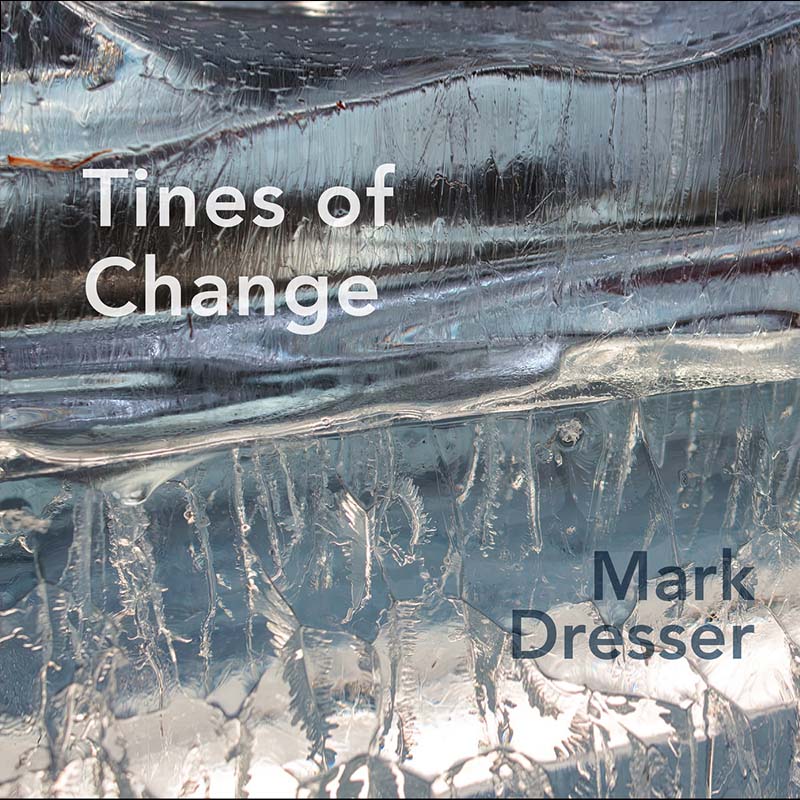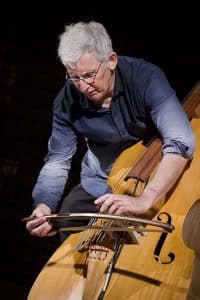Mark Dresser redefines the bass anew: ‘He’s unique!’ says Pulitzer-winning composer Anthony Davis
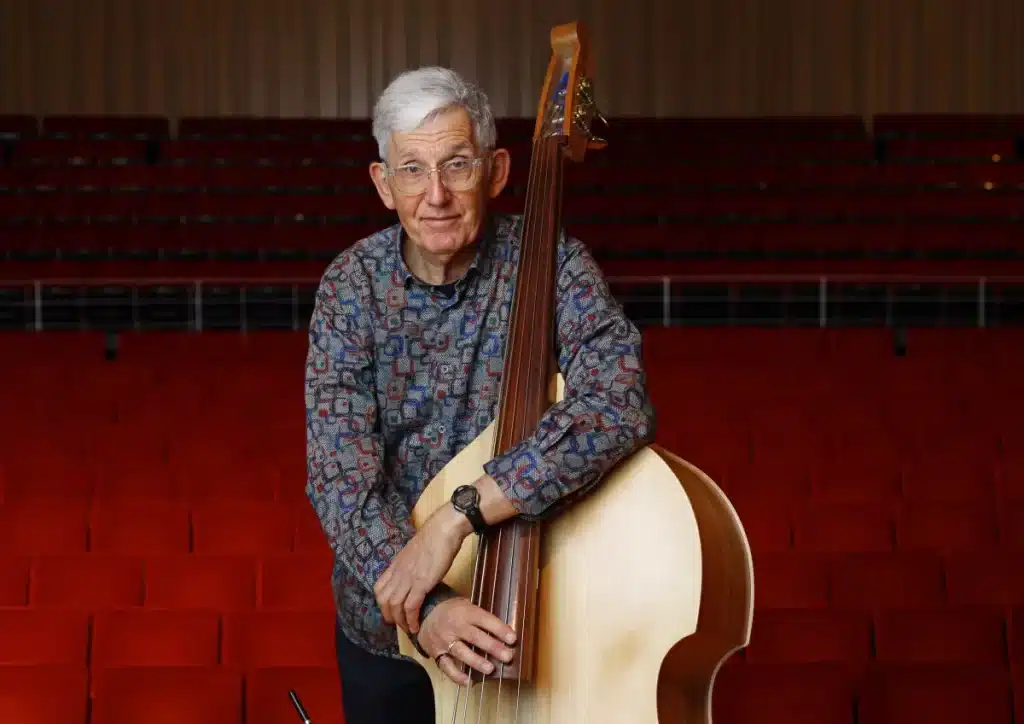
(K.C. Alfred/The San Diego Union-Tribune)
Only 20 when he joined the San Diego Symphony, this UCSD music professor makes bold leaps on his new ‘Tines of Change’ album. It features him using African thumb piano-inspired metal rods mounted on his four- and five-string basses
Exactly how many hands does Mark Dresser have?
Awed concert audiences around the world have often pondered this question after hearing Dresser — one of the most bold, distinctive and gifted bassists of his time — perform.
It is also a question raised by his wonderfully audacious new solo album, “Tines of Change,” a shape-shifting musical kaleidoscope that rewards attentive listening and at times suggests several bassists, not just one, performing together. Its title is a nod to the groundbreaking instrument within an instrument Dresser performs on for much of the album.
“Mark brings a whole cosmos of music into his playing that no one else does,” said Pulitzer Prize-winning composer and fellow University of California San Diego music professor Anthony Davis.
Dresser and Davis have been friends and collaborators for nearly 50 years. Their most recent recording together is on the upcoming album version of Davis’ Pulitzer-winning 2019 opera, “The Central Park Five.”
The high esteem Davis has for Dresser’s visionary artistry is shared by pianist Joshua White and vocal wizard Diamanda Galas. She has known the bassist even longer than Davis has.
“Mark combines a colossal innovation in the style and vocabulary of bass playing. It is the creation of an entirely new instrument,” Galas said. She first collaborated with Dresser in the early 1970s when both were members of the cutting-edge Southern California jazz band Black Music Infinity.
White began making music with Dresser nearly 15 years ago. He is featured on two superb albums — 2016’s “Sedimental You” and 2019’s “Ain’t Nothing But A Cyber Coup & You” — by the talent-rich Mark Dresser Seven.
“Mark only has two hands, but when he plays I think of how many neuro-connections he has firing at any given time,” said White, who will perform with Dresser’s septet June 14 at the prestigious Vision Festival in Brooklyn, N.Y.
“Mark has so many ideas, and they come so quickly,” White elaborated. “He’s always incredibly creative in approaching his original music compositions and in a purely improvisational context.”
Dresser will celebrate the release of his new solo album with a free Monday concert at The Loft at UC San Diego. He’ll play the first set unaccompanied, then be joined poet Jerome Rothenberg, a two-time PEN Literary Award winner for the second set.
“My man, Jerome, is 91 and still throwing down hard!” Dresser said. “I just recorded an album with him for John Zorn’s record label, Tzadik.
“There are endless musical possibilities in front of me. And I’m more into exploring them now, at 70, than I ever have been, which is wild.”
‘The power of music’
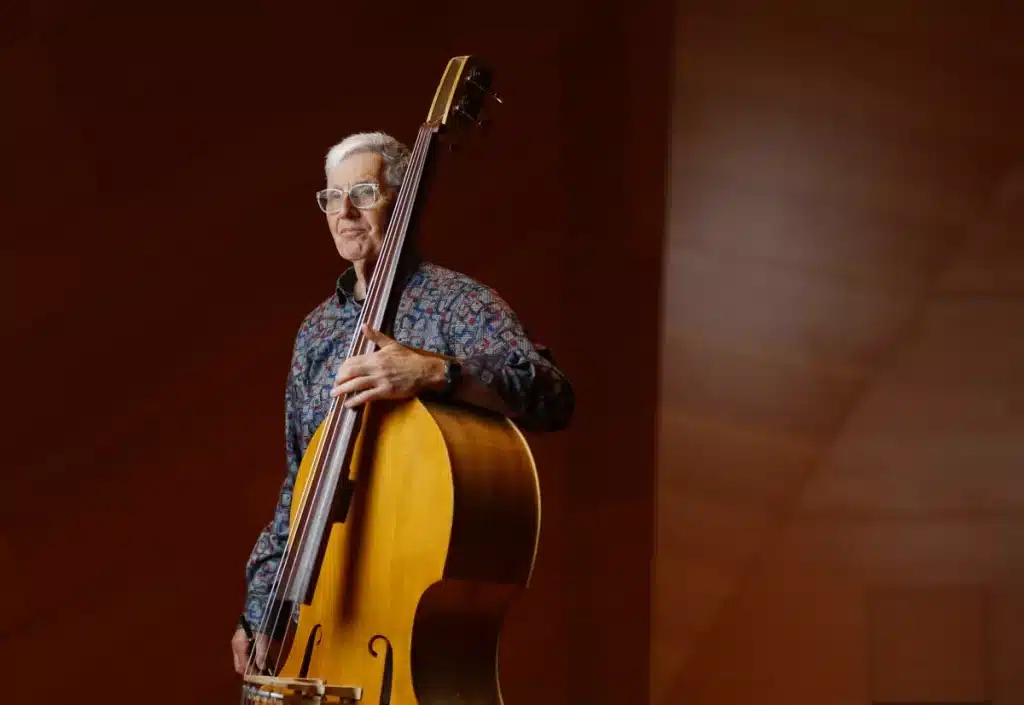
(K.C. Alfred/The San Diego Union-Tribune)
Dresser’s technical command of his instrument is matched by the emotional depth he brings to each note.
By expertly plucking, bowing, tapping or pulling on the strings — or deftly doing more than one of those things concurrently — he is able to create melodies, textures and rhythms that ingeniously extend the whisper-to-a-scream range and depth of the bass. In his hands, the instrument is capable of achieving panoramic dimensions.
Or, as Dresser noted in a 1988 Union-Tribune interview: “I see the bass having an extremely rich timbral palette, and I like to use all of it. I hear a lot of voices in my head — flutes, cellos, even trains — and I can play them on the bass.”
His first instrument was the piano, but he and the bass were clearly made for each other. The dazzling scope and tradition-expanding breadth of Dresser’s music evokes the spirit of two of his abiding musical inspirations — Jimi Hendrix and jazz bass giant Charles Mingus.
“The deep expression in Mingus’ playing really touched me,” he said. “So did Hendrix and the (electronic) feedback and harmonics he got playing near the bridge of his guitar.”
Born into a musical family in Los Angeles, he started piano lessons at 5 and took up the bass at 10. He experienced an early musical epiphany at 12, when he and a friend performed some folk music songs in Griffith Park.
“There was a Girl Scout convention nearby,” Dresser recalled. “And when we started playing, these girls started screaming for us. I remember feeling elevated, like: ‘Man, I’m going with this!’
“That sounds very superficial, I know. But I felt like this was beyond who I was and that I was tapping into something bigger than I am. That’s when I experienced the power of music to move listeners. I don’t have a specific audience in mind, but I want to play for as many people as I can.”
After stints as a teenager in the Burbank Youth Symphony and the Burbank Symphony, Dresser began a two-year stint — at the age of 20 — with the San Diego Symphony in 1972. That was two years after he had enrolled at UCSD, where his studies with modern bass pioneer Bertram Turetzky had a dramatic impact on him.
“I was 16 when I first heard Bert and the richness and fatness of his sound was something I’d never heard before,” Dresser recalled. “Studying with him and learning from him was life-changing.”
In his late teens, Dresser began playing with such San Diego jazz mainstays as pianist Butch Lacy. In 1974, he moved to New Haven, Conn., and then to New York. In 1983, he moved to Italy to study bass with Franco Petracchi under a Fulbright scholarship.
After further sojourns in San Diego and again in New York, Dresser was hired in 2004 to join the music faculty at UCSD, where he had earned both his bachelor’s and master’s degrees. He lives in Encinitas with his wife, Carol Del Signore.
Dresser’s many musical collaborators over the years have included trombonist and computer music pioneer George Lewis, saxophonist Anthony Braxton, South Korean string master Yoon Jeong Heo, Grammy-winning opera singers Susan Narucki and Dawn Upshaw, Wilco guitarist Nels Cline, Japanese pianist Satoko Fujii, Laurie Anderson and the St. Lawrence String Quartet.
An innovator’s innovator, Dresser is equally notable as a composer, band leader, improviser and key contributor to the dozens of albums by other artists that feature him. A master of harmonic overtones, he is a razor-sharp conceptualist who is constantly exploring new creative terrain. He is also a maverick of interdisciplinary music-making.
Since at least 2007, Dresser has been at the forefront of telematic concerts, which bring together improvising instrumentalists in different cities and countries to perform live, long distance. They do so while listening to and watching each other, in real time, thousands of miles apart, using extremely fast broadband connections.
In any musical setting, Dresser’s goals have remained constant. But articulating those goals is not Dresser’s favorite thing to do.
‘The twilight zone’
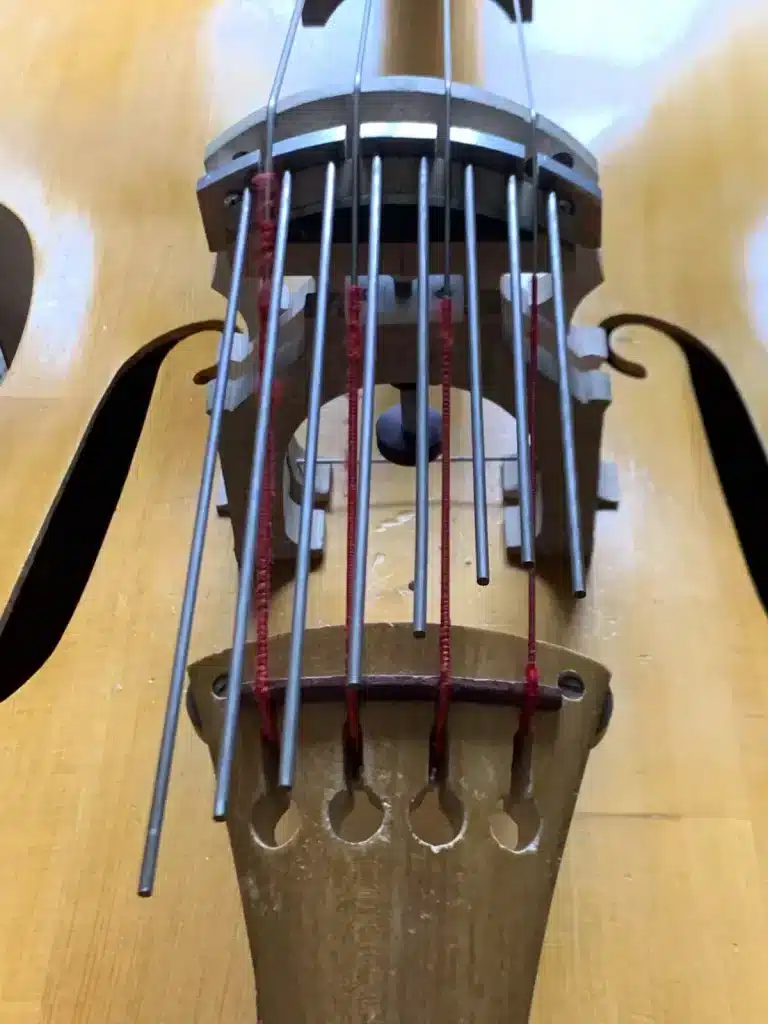
(Mark Dresser)
“When I talk about this stuff, I cringe,” Dresser said. “Because I feel like I’m making this sound much less interesting than it is to me. I have tools — these instruments that I’m so engaged and fascinated with — and I always want to try and get to the next step.
“Sure, I’m working on my instrumental vocabulary and techniques. But it’s always about finding the musical juice. Without that, I’m not interested. I want to feel more and tap into sounds that give me a range and help me identify contemporary life.
“I want to feel something and be stimulated, musically, which means exploring the universe of melody, rhythm, harmony form and sound.”
His take-no-prisoners explorations can be intense, challenging, playful, haunting, twisty and inviting, sometimes in rapid succession or seemingly all at the same time.
“Mark’s bass music is in the twilight zone,” Galas said. “He names his devils and hitches them aboard. The ride is unceasing in momentum. He is a medium for the propulsion of sound that separates music from mere sound: music (that) can be driven to the gods.”
“What Mark brings,” said Davis, “is a total commitment to music. His passion for what he does is so profound that it’s always inspiring.”
That commitment manifests in new ways on “Tines of Change.” The album was released Friday by Pyroclastic Records, an independent label based in New York.
“For the past couple of years, I’ve been working on a bass book that was supposed to come out with this album, but I’m not done writing it yet,” said Dresser, whose canceled concert tours during the pandemic shutdown were an impetus to start the book.
“I’ve been trying to go beyond what I know, and it’s been wonderful, totally expansive. I’ve often felt like Don Quixote, chasing windmills and going down rabbit holes. The book is for my bass-playing peers, but I hope the album is for everyone.”
“Tines of Change” features 12 selections by Dresser. Each is the result of in-the-moment improvisations that he then digitally edited to create new pieces. There is no double-tracking. As in his concerts, the only electronic effect he uses is a volume pedal.
Some of the titles pay homage to their inspirations, be it Gregorian chants (“Gregoratyne”) or avant garde Japanese percussionist Tatsuya Nakatani (“Nakatanitine”).
Recorded on July 21, 2019, and last Nov. 13 and 14 with audio engineer Alexandria Smith, “Tines of Change” features Dresser performing on unique four- and five-string basses. Both were made for him in Denver by fellow bassist and luthier Kent McLagan.
Both instruments, like the previous custom-made basses McLagan crafted for Dresser, include a pair of special hand-wound magnetic-coil pickups that are embedded into the fingerboards of the instruments. The pickups enable Dresser to sound as many as three pitches on each string. They also enable the amplification of especially nuanced tones and pitches that might not be audible otherwise.
But “Tines of Change” raises the bar considerably higher for both Dresser and McLagan, a jazz bassist who has degrees in engineering from Yale and Stanford.
The album’s title references the metal tines that — at Dresser’s request — McLagan built and affixed to a secondary bridge on each of the basses built for Dresser.
What Dresser envisioned, and McLagan made a reality, was that the steel and metal alloy rods from which the tines are made would combine elements of two very different instruments.
One is the mbira, a Zimbabwean thumb piano. The other, created by the late San Diego composer Robert Erickson, is perhaps even more unexpected: stroked rods, the name Erickson gave to an array of aluminum rods that required rosined gloves to play.
“The tines are metal rods, affixed to mountings, that look a lot like a mbira — but without the resonating box made out of a gourd that a mbira would have,” McLagan explained, speaking from his Denver studio.
“Mark’s the only guy in the world who has tines on his bass. It was his idea and I’m surprised and intrigued by the sounds he gets and his coordination of different sonic elements.
“Each time I listen to his ‘Tines of Change’ album, I hear something new. Even the ‘conventional’ sounds Mark makes, whether bowed or plucked, are often combined with untypical sounds to produce the richly varied musical world he is exploring.”
Dresser first used tines on his 2017 solo bass album, “Modicana.” But it took seven years of experimentation with prototypes, between 2015 and last year, for McLagan to build and hone tines that met Dresser’s exacting specifications. For an added twist, some of the tines are sub-audio, which means what Dresser plays on them can be felt by listeners, but not actually heard.
The tines are attached directly below the bridge of his basses. Their location that low on the instruments requires him to lean forward in order to play them.
“The tines are cantilevers,” Dresser explained. “I usually play them with my right hand, but sometimes I play them with both hands. More often than not, my left hand is on the strings and I’m bowing or plucking with my right. I have sets of eight, seven and six tines of different lengths, most often made of stainless steel.”
Playing the tines on his bass expands Dresser’s already expansive instrumental scope even further.
At times on “Tines of Change,” he sounds as if he is playing the aboriginal Australian wind instrument known as a didgeridoo. On “Gregoratyne,” he engages in an ingenious call-and-response sequence with himself. The whistling harmonics he performs create a beguiling aural shower of overtones.
“Why does someone want to do something different?” Dresser mused. “The answer, for me, is always: ‘Because it’s interesting.’ So, why not?
“I find new possibilities and where the sweet spots are — things that I didn’t understand before, but I do now. This is common to anyone learning a new language. I like discovering the nether regions of what an instrument can do. But this is all done before you get to the question: ‘Where is the music?’ And that is always the most important part.
“I’m fascinated by these different possibilities. They are obviously endless and I feel completely blessed. I don’t know if it’s a blessing for my loved ones, though, because I’m obsessed!”

